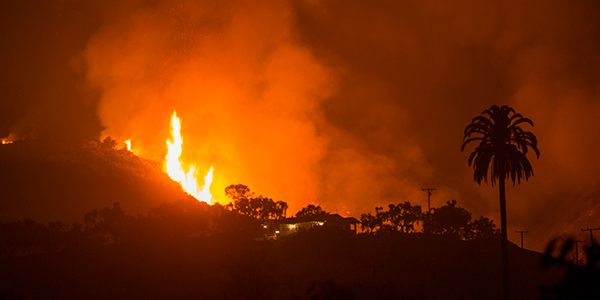By Hudson Sangree
Edison International’s president said in an earnings call Tuesday that equipment owned by its Southern California Edison subsidiary was at least one cause of a December 2017 wildfire that burned nearly 282,000 acres and resulted in multiple deaths.
The Thomas Fire in Santa Barbara and Ventura counties was the state’s largest wildfire in modern history until a combined series of Northern California blazes, the Mendocino Complex, greatly exceeded it this year. The Thomas Fire was directly blamed for the death of a firefighter and a civilian. Mud and debris flows in its aftermath killed 21 others when heavy rain drenched scarred mountain slopes.
“Based on the progress of our ongoing work in these areas with the information currently available to us, we believe that the Thomas Fire … had at least two separate ignition points,” Pedro J. Pizarro, Edison’s president and CEO, said during the earnings call. “With respect to one of these ignition points, Koenigstein Road, SCE believes that its equipment was associated with this ignition.”
The company hasn’t determined if a second ignition point in the Anlauf Canyon area also involved its equipment, Pizarro said. The California Department of Forestry and Fire Protection is also investigating the fire.
As with other California utilities’ wildfire liabilities, Edison’s could prove costly. California employs a unique system of holding electric providers strictly liable for property damage if their equipment sparks wildfires, even if they followed all rules and regulations. Pacific Gas and Electric is facing billions of dollars in liability for Northern California fires last year, which has undermined its stock price.
Edison may face similar problems. The company reported third-quarter earnings of $513 million ($1.57/share) on Tuesday, compared with $470 million ($1.43/share) in the third quarter of 2017 — the increase largely attributed to deferral of operations and maintenance costs and tax benefits at SCE. But it also discussed its potential financial exposure from the Thomas Fire and highlighted its wildfire prevention efforts with investors.
“Mitigation and prevention are the best defenses against future wildfires,” Pizarro said.
The company’s California plans call for spending $407 million on grid hardening, enhanced operations and “situational awareness” of wildfire risks, he said.
Much of the money will be used to replace 600 circuit miles of bare wire with insulated wire over the next two years in areas at high risk from wildfires, the CEO said. SCE has identified another 3,400 circuit miles of bare overhead conductors in fire-prone regions, he said.
The company’s plans are in line with the goals of SB 901, a bill the California legislature passed this year that requires utilities to file wildfire mitigation plans with the state, he noted. (See California Wildfire Bill Goes to Governor.)
Pizarro said Edison is also seeking to comply with another landmark bill, SB 100, which requires the state to rely entirely on renewable and other zero-carbon energy sources by 2045. The measure sets goals along the way, including achieving 60% renewable energy reliance by 2030. (See California Gov. Signs Clean Energy Act Before Climate Summit.)
“We found the most feasible pathway to reach the state’s 2030 goals to be an electric grid supplied by 80% carbon-free energy made reliable by up to 10 GW of energy storage,” Pizarro said on the call.
“This will support at least 7 million electric vehicles on California roads and nearly one-third of space and water heaters powered by electricity,” he added.
Call transcript courtesy of Seeking Alpha.





